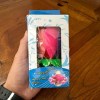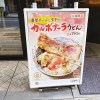![efbc917[1]](https://soranews24.com/wp-content/uploads/sites/3/2012/08/efbc91711.jpg)
Did you know that along with the ultra violet rays of the sun, summer heat reduces collagen in the skin? We have enough to worry about with what aging does to our collagen reserves! The winter provides lots of opportunity to boost collagen intake through eating gelatinous ingredients like pork and chicken cartilaginous cuts of meat, in nabe, the hot-pot dish where everyone helps themselves while sitting around a steaming pot of simmering ingredients. But who wants to eat nabe in summer!
Gelatin is the answer! Gelatin consists of collagen and is used to gel things. A web search for good gelatin recipes resulted in finding jellied eggs from this website, ediva, “Jellied Eggs: Great Recipe for Easter”. Well it isn’t Easter but never mind, jellied eggs can also be eaten in the hot summer, a cooling healthy treat.
With jellied eggs, not only do you get to boost your collagen, but these are also very attractive. They would make excellent hors d’ oeuvres at any event where you are entertaining guests at home. You can ‘wow’ your friends! Don’t forget to remind them of the benefits to their skin, they’ll be even more impressed.
With this great concept of jellied eggs, we came up with our own recipe. If you are a creative cook, you could probably come up with your own perfect jellied egg, tapered to your own tastes. Just imagine the creative combinations of meat and vegetables that you could use. You may come up with such a beauty that you will want to decorate your living room with it! Although these jellied eggs are savory, think sweet. Doesn’t that open a whole new door of possibilities!?
Here are the ingredients for our version of the jellied egg:
- 2 eggs
- 2 teaspoons consomme’
- 5 grams of gelatin
- 80 ml hot water
- 100 grams of bacon
- 1/4 red paprika
- 1/4 yellow paprika
- some finely chopped parsley
- about 4 cm of lemon rind
Here are the utensils you will need:
- 2 egg cups or shot glasses will also do. Anything you can stand an egg in
- a thick needle like a sewing machine needle, any sharp item of similar thickness
- a pan
- a funnel If you don’t have a funnel one can be easily made by rolling cooking paper into a cone and taping it securely.
- a small cup for leftovers
Instructions:
You need the eggs shells intact as molds for the ingredients. You won’t be needing the insides of the egg so you can put them away for tomorrows breakfast. There needs to be a hole big enough to funnel in the ingredients. Make this by gently twisting your needle into the eggshell. perforate a circle into the top of the egg. Like this:
Chop up the vegetables, bacon and lemon rind into fine bits.
Fill the egg shells three-fourths full with the mixture of vegetables, bacon, and lemon rind. Stand your filled egg shells up in your egg cups or shot glasses or whatever means you have chosen to keep them upright. Put the remainder of mixture into the small cup.
Now dissolve your consomme’ and gelatin into the hot water. Stir it well to make sure that it fully dissolves.
Funnel the gelatin mixture into the eggs as well by pouring it through the funnel into the egg-shell to the top. The leftover gelatin mixture can be poured into the small cup over the leftover vegetable, bacon, and lemon rind mixture.
Now the jellied eggs are ready to be chilled for about three hours. The little cup filled with the gelatin /vegetable, bacon and lemon rind mixture can be the tester to check the consistency of how well the mixture is settling in its egg mold.
Once you are sure they have jelled properly you can peel away the egg-shell. Wallah! You have your jellied egg! It looks even prettier if you run water gently over its surface, giving it a fine sheen.
What do you think of this unique creation? Before you know it, you may see and feel the effects of the collagen on your skin. Of course if you are eating alone only for your skin, then it may not be necessary to bother making the eggs. The mixture can be poured into cups and chilled. But if you want to make a point of the presentation then what better way than with jellied eggs!
Oh, something you might not want to forget when dealing with gelatin: A finished jellied egg will melt when left out in the heat. What a pity if all that effort melted away! If you are not going to eat your creations right away, it is highly recommended that they be refrigerated.
[ Read in Japanese ]

![efbc926[1]](https://soranews24.com/wp-content/uploads/sites/3/2012/08/efbc9261.jpg)
![efbc936[1]](https://soranews24.com/wp-content/uploads/sites/3/2012/08/efbc9361.jpg)
![efbc946[1]](https://soranews24.com/wp-content/uploads/sites/3/2012/08/efbc9461.jpg)
![efbc956[1]](https://soranews24.com/wp-content/uploads/sites/3/2012/08/efbc9561.jpg)
![efbc966[1]](https://soranews24.com/wp-content/uploads/sites/3/2012/08/efbc9661.jpg)
![efbc975[1]](https://soranews24.com/wp-content/uploads/sites/3/2012/08/efbc9751.jpg)
![efbc985[1]](https://soranews24.com/wp-content/uploads/sites/3/2012/08/efbc9851.jpg)
![efbc995[1]](https://soranews24.com/wp-content/uploads/sites/3/2012/08/efbc9951.jpg)
![efbc91efbc903[1]](https://soranews24.com/wp-content/uploads/sites/3/2012/08/efbc91efbc90311.jpg)
![efbc91efbc912[1]](https://soranews24.com/wp-content/uploads/sites/3/2012/08/efbc91efbc91212.jpg)
 How to make awesome glow-in-the-dark jelly shots【RocketKitchen】
How to make awesome glow-in-the-dark jelly shots【RocketKitchen】 We make a huge 12-litre chunk of jelly in a giant Starbucks mug to celebrate “Jelly Day” in Japan
We make a huge 12-litre chunk of jelly in a giant Starbucks mug to celebrate “Jelly Day” in Japan Raw, frozen eggs are the new food trend in Japan, apparently
Raw, frozen eggs are the new food trend in Japan, apparently How to make cheese with just three ingredients【SoraKitchen】
How to make cheese with just three ingredients【SoraKitchen】 Katsudon for breakfast? Japan’s new bacon egg cutlet bowl may be the only meal we need all day
Katsudon for breakfast? Japan’s new bacon egg cutlet bowl may be the only meal we need all day Foreigner’s request for help in Tokyo makes us sad for the state of society
Foreigner’s request for help in Tokyo makes us sad for the state of society Red light district sushi restaurant in Tokyo shows us just how wrong we were about it
Red light district sushi restaurant in Tokyo shows us just how wrong we were about it McDonald’s new Happy Meals offer up cute and practical Sanrio lifestyle goods
McDonald’s new Happy Meals offer up cute and practical Sanrio lifestyle goods Anime girl English teacher Ellen-sensei becomes VTuber/VVTUber and NFT
Anime girl English teacher Ellen-sensei becomes VTuber/VVTUber and NFT Historical figures get manga makeovers from artists of Spy x Family, My Hero Academia and more
Historical figures get manga makeovers from artists of Spy x Family, My Hero Academia and more Japan’s massive matcha parfait weighs 6 kilos, contains hidden surprises for anyone who eats it
Japan’s massive matcha parfait weighs 6 kilos, contains hidden surprises for anyone who eats it Celebrate another year of life by putting it in jeopardy with this birthday candle flower
Celebrate another year of life by putting it in jeopardy with this birthday candle flower Japanese ramen restaurants under pressure from new yen banknotes
Japanese ramen restaurants under pressure from new yen banknotes Limited-edition Carbonara Udon will anger noodle purists and pasta lovers 【Taste test】
Limited-edition Carbonara Udon will anger noodle purists and pasta lovers 【Taste test】 Studio Ghibli releases new action figures featuring Nausicaä of the Valley of the Wind characters
Studio Ghibli releases new action figures featuring Nausicaä of the Valley of the Wind characters All-you-can-drink Starbucks and amazing views part of Tokyo’s new 170 meter-high sky lounge
All-you-can-drink Starbucks and amazing views part of Tokyo’s new 170 meter-high sky lounge French Fries Bread in Tokyo’s Shibuya becomes a hit on social media
French Fries Bread in Tokyo’s Shibuya becomes a hit on social media New private rooms on Tokaido Shinkansen change the way we travel from Tokyo to Kyoto
New private rooms on Tokaido Shinkansen change the way we travel from Tokyo to Kyoto Studio Ghibli glasses cases let anime characters keep an eye on your spectacles
Studio Ghibli glasses cases let anime characters keep an eye on your spectacles Tokyo Tsukiji fish market site to be redeveloped with 50,000-seat stadium, hotel, shopping center
Tokyo Tsukiji fish market site to be redeveloped with 50,000-seat stadium, hotel, shopping center Beautiful Ghibli sealing wax kits let you create accessories and elegant letter decorations【Pics】
Beautiful Ghibli sealing wax kits let you create accessories and elegant letter decorations【Pics】 Studio Ghibli releases Kiki’s Delivery Service chocolate cake pouches in Japan
Studio Ghibli releases Kiki’s Delivery Service chocolate cake pouches in Japan New definition of “Japanese whiskey” goes into effect to prevent fakes from fooling overseas buyers
New definition of “Japanese whiskey” goes into effect to prevent fakes from fooling overseas buyers Our Japanese reporter visits Costco in the U.S., finds super American and very Japanese things
Our Japanese reporter visits Costco in the U.S., finds super American and very Japanese things Studio Ghibli unveils Mother’s Day gift set that captures the love in My Neighbour Totoro
Studio Ghibli unveils Mother’s Day gift set that captures the love in My Neighbour Totoro New Japanese KitKat flavour stars Sanrio characters, including Hello Kitty
New Japanese KitKat flavour stars Sanrio characters, including Hello Kitty More foreign tourists than ever before in history visited Japan last month
More foreign tourists than ever before in history visited Japan last month New Pokémon cakes let you eat your way through Pikachu and all the Eevee evolutions
New Pokémon cakes let you eat your way through Pikachu and all the Eevee evolutions Sales of Japan’s most convenient train ticket/shopping payment cards suspended indefinitely
Sales of Japan’s most convenient train ticket/shopping payment cards suspended indefinitely Sold-out Studio Ghibli desktop humidifiers are back so Totoro can help you through the dry season
Sold-out Studio Ghibli desktop humidifiers are back so Totoro can help you through the dry season Japanese government to make first change to romanization spelling rules since the 1950s
Japanese government to make first change to romanization spelling rules since the 1950s Ghibli founders Toshio Suzuki and Hayao Miyazaki contribute to Japanese whisky Totoro label design
Ghibli founders Toshio Suzuki and Hayao Miyazaki contribute to Japanese whisky Totoro label design Doraemon found buried at sea as scene from 1993 anime becomes real life【Photos】
Doraemon found buried at sea as scene from 1993 anime becomes real life【Photos】 Tokyo’s most famous Starbucks is closed
Tokyo’s most famous Starbucks is closed One Piece characters’ nationalities revealed, but fans have mixed opinions
One Piece characters’ nationalities revealed, but fans have mixed opinions We asked a Uniqlo employee what four things we should buy and their suggestions didn’t disappoint
We asked a Uniqlo employee what four things we should buy and their suggestions didn’t disappoint Princesses, fruits, and blacksmiths: Study reveals the 30 most unusual family names in Japan
Princesses, fruits, and blacksmiths: Study reveals the 30 most unusual family names in Japan Ultimate TKG: We’ll never eat tamago kake gohan the old way again! 【Sora Kitchen】
Ultimate TKG: We’ll never eat tamago kake gohan the old way again! 【Sora Kitchen】 There’s a Makoto Shinkai anime-inspired tea in Japan, and it’s beautiful like his films
There’s a Makoto Shinkai anime-inspired tea in Japan, and it’s beautiful like his films This French toast recipe that uses ice cream will knock your pajamas off【SoraKitchen】
This French toast recipe that uses ice cream will knock your pajamas off【SoraKitchen】 Waste not, want not: Japanese netizens share delicious ways they prepare watermelon rinds
Waste not, want not: Japanese netizens share delicious ways they prepare watermelon rinds Get ‘em while they’re cold! Tokyo restaurant has chilled chicken skewers in collagen blocks
Get ‘em while they’re cold! Tokyo restaurant has chilled chicken skewers in collagen blocks How to turn your leftover instant ramen broth into delicious chawanmushi Japanese egg custard
How to turn your leftover instant ramen broth into delicious chawanmushi Japanese egg custard Japan has eggs that smell and taste like yuzu citrus fruit, and they’re amazing!
Japan has eggs that smell and taste like yuzu citrus fruit, and they’re amazing! How drunk can Awamori Jelly infused with liquor from Okinawa make us?
How drunk can Awamori Jelly infused with liquor from Okinawa make us? Which Japanese convenience store has the best onsen tamago hot spring eggs?
Which Japanese convenience store has the best onsen tamago hot spring eggs? Now you can have beauty-conscious non-alcoholic beer from Suntory!
Now you can have beauty-conscious non-alcoholic beer from Suntory! The Zenyaren restaurant in Otemachi offers water jelly for the summer … with chicken inside it!
The Zenyaren restaurant in Otemachi offers water jelly for the summer … with chicken inside it! Japanese YouTuber tests out homemade Water Cake three different ways【Video】
Japanese YouTuber tests out homemade Water Cake three different ways【Video】 We try a method for making ice cream that doesn’t require a freezer【SoraKitchen】
We try a method for making ice cream that doesn’t require a freezer【SoraKitchen】 How to make a cartoon cheesecake that looks like Swiss cheese
How to make a cartoon cheesecake that looks like Swiss cheese Dumplings that’ll make you pretty! “Gyoza for girls” is the new food trend hitting Japan!
Dumplings that’ll make you pretty! “Gyoza for girls” is the new food trend hitting Japan! Our Japanese reporters actually like the Eggstractor, deem it an important step in egg technology
Our Japanese reporters actually like the Eggstractor, deem it an important step in egg technology
Leave a Reply